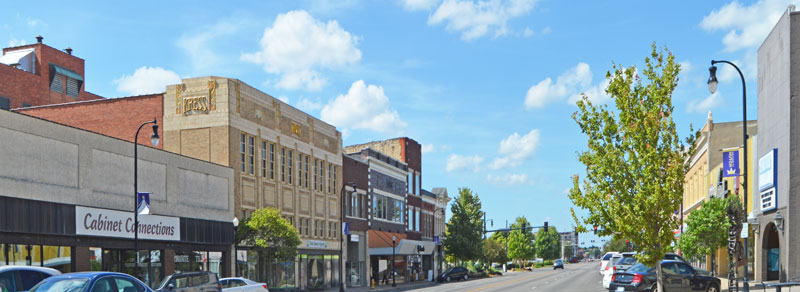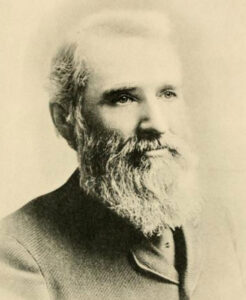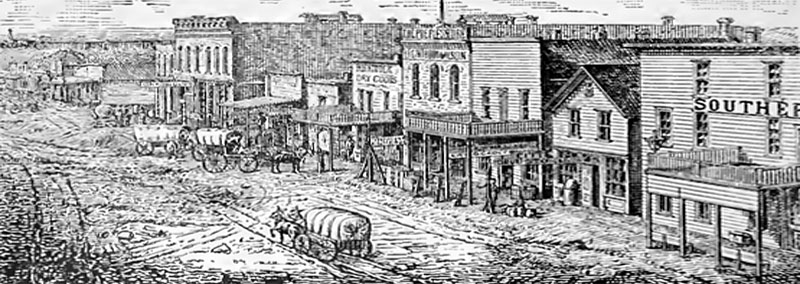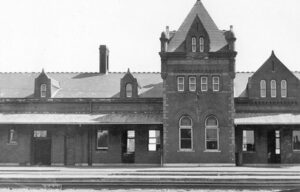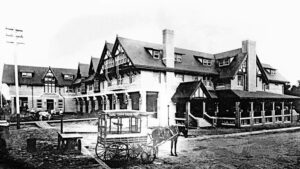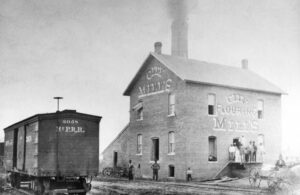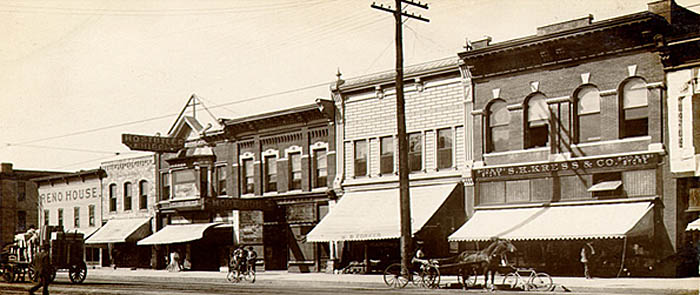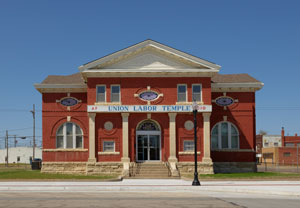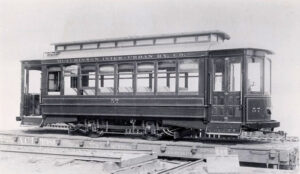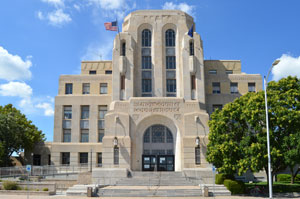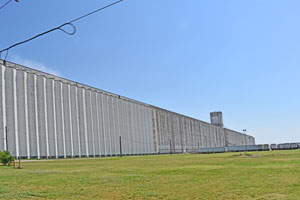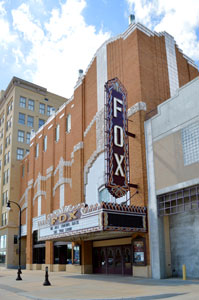Hutchinson, Kansas, is the largest city and county seat in Reno County. Nicknamed “Salt City” for the salt mines discovered in 1887, it is located on the Arkansas River in the central part of the state. As of the 2020 census, the population of the city was 40,006.
Hutchinson was founded in 1871 when frontiersman Clinton Carter “C.C.” Hutchinson contracted with the Atchison, Topeka & Santa Fe Railroad to establish a town at the railroad’s crossing over the Arkansas River. Named for its founder, the city was platted in November 1871, its first streets lying on both sides of Cow Creek near where the new Santa Fe Railroad was to cross the Arkansas River. To encourage settlement by sober, industrious persons, Hutchinson included a clause in the deed to each lot specifying that if liquor were sold or given away before 1875, the property and all improvements would revert to the original owner. After 1875, Hutchinson hoped that the moral sentiment of the settlers would be strong enough to control the liquor traffic. This earned the community the nickname “Temperance City.” Liquor was sold outside the limits, as there was no county government at the time. However, some offenders were arrested by United States Marshals.
To the builder of the first house on the townsite, Hutchinson offered to give one of the choice lots in the settlement. This prize was won by A. F. Homer, who moved a black walnut building from the nearby town of Newton. The first commercial building on the site was erected in the fall of 1871, which was a grocery store, the meat market, and contained the real estate office of C. C. Hutchinson. Others who opened stores were W. Bailey, a general store; T. F. Leidigh, grocery; Jordan & Bemis, a general store; E. Wilcox, hardware and farm implements; J. S. Fay, opened a hotel; and J. & C. McMurray, a livery stable. Having visions of Hutchinson as a prairie metropolis and a seat of culture and learning, the settlers made plans for churches and schools soon after their arrival. The first regular church meetings were held in a building that, on weekdays, served as a butcher shop.
In 1872, the Atchison, Topeka & Santa Fe Railroad was built past this point; town founder C.C. Hutchinson started the first bank; the Hutchison News was founded on July 4, and Miss Jennie Hodgson taught the first school in a small frame building on Main Street. That year, C.C. Hutchinson was elected to the legislature, and through his efforts, Hutchinson became the county seat. In August 1872, the new town had a sufficient population and was incorporated as a third-class city. The first officers were Mayor Taylor Flick, police judge J. B. Brown, councilmen John McMurray, G. A. Brazee, E. Wilcox, R. C. Bailey, and D. M. Lewis.
The first Reno County Courthouse was constructed shortly after the city was established in 1872. The simple, square brick structure stood at Avene B and Main.
Hutchinson held Reno County’s first fair in 1873.
By 1878, C.C. Hutchinson had erected the state’s first water mill at Hutchinson.
In 1882, the Hutchinson Opera House was built by public subscription on the northeast corner of First Avenue and Main Street. The Hutchinson News carried long paragraphs on the activities of Hutchinson’s cultural societies. The town’s social leaders sponsored home talent performances at the opera house for special occasions when “traveling talent” was unavailable.
By 1885, Hutchinson had become important as a shipping and trading center. The production of Turkey Red wheat, a variety remarkably adaptable to prairie soil, was increasing yearly. Its increase was accompanied by the growing importance of Hutchinson as a milling center. A few years later, following natural gas discovery, a wave of prosperity swept southwestern Kansas.
In September 1887, local salt deposits were discovered for the first time when Ben Blanchard, a land speculator who founded South Hutchinson, drilled for oil in the area. This gave rise to the first salt-processing plants west of the Mississippi River. The salt was initially extracted using evaporation by pumping water into brine wells. Salt mining would become a significant industry in Hutchinson.
That year, the Chicago, Kansas, and Nebraska Railway built a main line from Herington through Hutchinson to Pratt. In 1888, this line was extended to Liberal. Later, it was extended to Tucumcari, New Mexico, and El Paso, Texas. It foreclosed in 1891 and was taken over by the Chicago, Rock Island & Pacific Railroad.
In 1900, the city’s population was 9,379.
By 1900, many referred to the Hutchinson Fair as the Kansas State Fair, even though there was no state-supported Kansas State Fair yet.
In 1901, a new courthouse was built just east of the first courthouse on the Southeast corner of Avenue B and Main. In 1925, courthouse employees began to notice cracks forming throughout the building. Within the next month, the cracks worsened, and the building was evacuated. After examining the grounds around the courthouse, it was discovered that the Carey Salt and Cold storage facility next door was the culprit. Emerson Carey offered to buy the Courthouse and the land around it. Ultimately, Carey was sued for $200,000, and the courthouse was razed in 1929.
The Bisonte Hotel, a Harvey House Hotel and restaurant, was built in 1908. Bisonte is Spanish for bison. Fred Harvey began his relationship with the Atchison, Topeka & Santa Fe Railroad in 1876 and built his first hotel in Florence, Kansas. Harvey spent extravagantly to furnish his hotels and insisted on good food and lodging. The staff was impeccably trained and paid a fair wage. The Bisonte originally had 74 rooms with bathrooms in between each room with hot and cold running water. Meals could be telegraphed into the hotel from the approaching trains so that their food would be ready when travelers arrived at the station. At the time, this was all extravagant traveling fare, and the construction costs for the Bisonte Hotel made it the most expensive hotel on the entire Santa Fe line. By the 1940s, the Bisonte had passed its prime due to the decline in rail services and was closed in 1946. It then passed into the hands of the American Legion. In 1964, it was sold to investors in Wichita to turn it into a Ramada Inn. During the demolition phase, the Bisonte burned to the ground in 1965.
In 1910, Hutchinson had excellent railroad facilities, fine hotels, extensive manufacturing and jobbing interests, shady streets, beautiful buildings, and many automobiles. A home-owned electric street railway system extended all over the city. The Hutchinson’salt plants had yielded 2,500 to 5,000 barrels of salt per day for the last 20 years, and the source seemed inexhaustible. The rock salt vein was 400 feet thick and found at a depth of 375 feet. The Hutchinson’s is unsurpassed as table salt. The amounts of money spent running these plants were enormous, the cost of fuel alone being more than the amount received for salt sold within the state, the profits coming from export sales — and that with natural gas for fuel at ten cents per 1,000 feet.
The various flour mills had a combined capacity of 3,000 barrels per day, most of which were shipped out of the country by Galveston. The elevators had a storage capacity of 6,500,000 bushels. The soda ash plant, probably the largest institution of its kind in the country, manufactured the raw material or base of all soda products. The wholesale business aggregated $11,500,000 annually, and 400 traveling salesmen, representatives of Hutchinson firms, had their homes here. There was a meat packing establishment, and the extensive poultry and egg business brought significant returns. There were foundries, a strawboard factory, a canning factory, a paint factory, a creamery, a blank book manufacturer, a machine shop, a furniture factory, and boiler works. The five Hutchinson banks had a combined capital of over $500,000, and they were among the few banks in the country that did not in some manner restrict cash payments during the panic of 1907.
At that time, the city was paved, lighted with electricity, and had a good sewer system, waterworks, an efficient fire department, and a police force. The finest hotel between the Great Lakes and the Pacific coast and the best retail stores between the 6th principal meridian and the Continental Divide were located here. Hutchison was also the site of the state reformatory. It had a live commercial club, which continually induced new factories and commercial enterprises to locate there. The railroad facilities were greatly to their advantage in these matters and had been one of the principal factors in the city’s growth into an important commercial and manufacturing center. The main lines of both the Chicago, Rock Island & Pacific and the Atchison, Topeka & Santa Fe passed through the city; the Missouri Pacific Railroad line from Ellsworth to Wichita ran through Hutchinson, and there were two additional lines of the Atchison, Topeka & Santa Fe, one running south and the other running west to Kinsley, where it met the main line. The freight hauled from Hutchinson by the Santa Fe alone amounted to more tons per month than that of any town on the line except Kansas City and the terminals. Hutchinson ranked sixth among all the towns on the road, terminals included. A fair association owning extensive grounds and buildings holds a state fair annually at Hutchinson. Exhibits of livestock and agricultural products come from all over Kansas and neighboring states.
Aside from her money-making interests, Hutchinson had other valuable assets, not the least of these being her large and beautiful shade trees. A Carnegie library, many fine churches, and the best schools made the town attractive from an intellectual and religious standpoint. The population in 1910 was 16,364 and rapidly increased due to the labor needed in the factories. It was at the outlet of a great corn and wheat-raising district and had one of the largest salt works in the world.
In 1913, after lobbying in the Kansas Legislature, Hutchinson gifted the State of Kansas the land that became the Kansas State Fairgrounds. The official Kansas State Fair has been held in Hutchinson ever since.
In 1915, the Wichita-based Arkansas Valley Interurban trolley-car system was established that connected Wichita, Newton, and Hutchinson. The line was initially designed to help foster growth between the three fastest-growing communities in this area of Kansas. With the Kansas oil boom of the 1920s, the line flourished. However, the commuter line struggled from the beginning. The rail companies did not like sharing the lines with commuters, and local Hutchinson businesses saw their customer base drop as it became easier to travel to Wichita to shop. Ultimately, the automotive industry put the final nail in the coffin of this venture. The last commuter train ran in 1938. The Terminal Station in Hutchinson still stands at 111 2nd Avenue East. When the line closed, the ownership of the building changed hands many times over the next 20 years, and more and more of the rail line was sold until all that remained was the building. It was listed on the National Register of Historic Places in 1983 when the first floor was a Trailways Bus station, and its second floor was unused. Today, it is utilized as a commercial space. It is the only structure left of the commuter company.
The Soldiers & Sailors Memorial at 1st Avenue and Walnut Street was erected in memory of veterans of the Civil War and dedicated in 1919. It is listed on the National Register of Historic Places today.
In the 1920s, oil wealth began to filter in from the south and west, and the plentiful supply of cheap natural gas fuel attracted many smaller industries.
Dillon’s grocery store was established in Hutchinson by J.S. Dillon in the 1920s. Dillon’s was later bought out by The Kroger Company in 1983. The company still operates a distribution center, and the headquarters for Dillons and Kwik Shop are in Hutchison.
In 1923, the Carey Salt Company opened the only salt mine in Hutchinson, producing rock salt. That mine is still in use today and is operated by the Hutchinson Salt Company. Cargill and Morton Salt also have evaporative salt plants in Hutchinson.
The six-story Reno County Courthouse, at the northwest corner of 1st Avenue and Adams Street, was completed in 1930. A fine example of modern architecture, it was built of Indiana Bedford stone, Virginia marble, and yellow brick, costing approximately $500,000. It is listed on the National Register of Historic Places today.
In 1931, the Fox Theater was built. One of the most iconic theaters in the state, it was designed by the Boller Brothers, who were known for building grandiose theaters. The flashing marquee was one of the first, and remains one of the last, to have flashing neon lights. The 1200-seat theater operated until 1985, when it closed. In 1990, Hutchinson’s Historic Theater Inc. conducted a multimillion-dollar renovation and reopened in 1999. It then began a new era presenting world-class artists and performers, various film series, and local productions, and it can be rented for various purposes. The theater retains almost all of its original interior, a rarity for most theaters of this time.
In the 1930s, Hutchison was described as “a city of mills and factories.” At this time, flour mills and the concrete cylinders of grain elevators dominated the industrial area, which lay approximately a mile east of the retail district. Nearby were the salt plants, a refinery, railroad yards, and numerous smaller industrial concerns. A second industrial district was along the railroad tracks on the west side of Hutchinson. Across the Arkansas River at the south city limits was another group of mills and elevators, another refinery, and a nationally known salt plant.
The importance of the salt industry to the city of Hutchinson was evident as “Salt City” was often substituted for Hutchinson in the names of business firms. Built above salt deposits, reputedly among the richest in the world, Hutchinson’s chief industry was the mining, processing, and shipment of salt. Deposits that underlie the greater part of the metropolitan area and the surrounding country were approximately 600 feet below the surface and ranged from 300 to 350 feet thick. The city’s three salt-processing plants shipped 3,000,000 barrels of salt annually to markets in all parts of the United States, and geologists estimated that the supply was practically inexhaustible. Plants and mines employed about 600 men.
Although somewhat less spectacular, Hutchinson’s wheat shipping and storage industry attained heights in “wheat years” untouched by the comparatively steady salt industry. As the seat of Reno County, Kansas’s most important wheat-producing area, Hutchinson was a key city for the shipment and milling of grain from the adjacent area and the great fields of southwestern Kansas. With eight elevators and three flour mills, Hutchinson had storage facilities for more than 10,000,000 bushels of grain. Claiming to be the smallest city in the world with its own grain market dealing in futures, Hutchinson pointed to a ten-year average of grain receipts at its markets from 1925 to 1935, exceeding 46,000,000 bushels a year. Thirty grain firms maintained offices in the city.
Surrounded by oil fields, Hutchinson’s petroleum industry had developed gradually but promised to exceed salt and wheat in importance. A producing well, flowing at the rate of 3,600 barrels of high-gravity oil a day, was only nine miles east of the city, and more than 1,500 additional wells were within a radius of 100 miles of the city limits. Adjacent to Hutchinson on the east was Kansas’ most productive gas well, yielding 128,600,000 cubic feet daily. Hutchinson had two refineries, numerous distribution and supply companies, and long dark lines of tank cars mingled with those loaded with wheat in its railroad yards.
In 1943, German and Italian prisoners of World War II were used in Kansas and other Midwest states to solve the labor shortage caused by American men serving in the war effort. Large prisoner-of-war camps were established in Kansas: Camp Concordia, Camp Funston at Fort Riley, and Camp Phillips at Salina under Fort Riley. Fort Riley also established 12 smaller branch camps, including one in Hutchison.
The world’s second-longest grain elevator was built in Hutchinson in 1961. The grain elevator, under one headhouse, is 2,573 feet. The longest, located in Wichita, Ks, is 2,657 feet long.
Today, Hutchinson remains a manufacturing town with the Eaton Corporation Hydraulics Plant; the Lowen Corporation, a provider of graphic solutions; the Collins Bus Corporation, StraightLine HDD, a leading directional drill tooling manufacturer; Siemens wind turbine assembly facility; and Kuhn-Krause, which manufactures agricultural equipment.
Each year, Hutchinson continues to host the Kansas State Fair. It is the home of the Kansas Cosmosphere and Space Center aerospace museum and Strataca (formerly known as Kansas Underground Salt Museum). Carey Park is the home of the Hutchinson Zoo, Carey Park Golf Course, and Salt City Splash outdoor aquatic center.
Hutchison is about 50 miles northwest of Wichita and 168 miles southwest of Topeka.
©Kathy Alexander/Legends of Kansas, updated October 2023.
Also See:
Sources:
Blackmar, Frank W.; Kansas: A Cyclopedia of State History, Vol I; Standard Publishing Company, Chicago, IL 1912.
Cutler, William G; History of Kansas; A. T. Andreas, Chicago, IL, 1883
Historic Downtown Hutchinson Tour
Federal Writers’ Project, WPA Guide to Kansas – The Sunflower State, 1939
Wikipedia·

